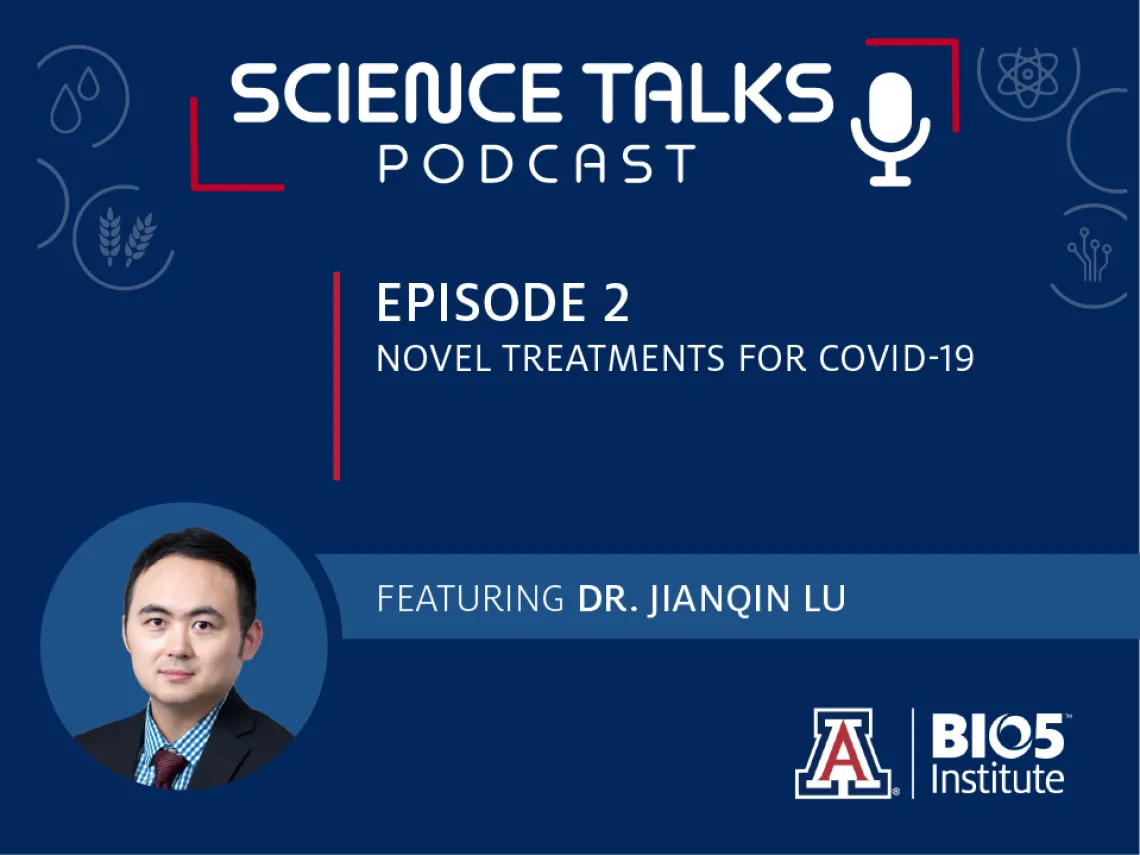Novel treatments for COVID-19
BIO5 COVID-19 seed grant awardee Dr. Jianqin Lu talks about his two novel approaches to treating COVID-19.

Dr. Jianqin Lu, BIO5 member and assistant professor in the College of Pharmacy, discusses his two BIO5 COVID-19 seed grant projects. The first focuses on the use of nanotechnology to improve efficacy and minimize toxicity of anti-malarial drugs against COVID-19, while the second project explores whether enhancing COVID-19 patients’ immune systems can treat their infections.
How did your background in pharmaceutical science allow you to quickly pivot your work to focus on COVID?
My lab focuses on developing therapeutics using nanotechnology to address the limitations associated with current therapies like toxicity. By turning toxic drugs into the nanodrugs, not only can we reduce the systemic toxicity associated with them, but it can also improve their therapeutic efficacy by preferentially delivering them to areas of disease while avoiding poisoning the healthy tissues.
This concept has been demonstrated in a number of FDA approved nanodrugs. The current drugs that have been used for treating COVID-19 also suffer from poor efficacy and adverse effects, which significantly limits their clinical application in treating COVID-19 patients. Just like it works for other types of drugs such as chemotherapies, nanotechnology can also help make existing COVID-19 drugs safer and more effective.
What types of drugs are you looking at for COVID-19?
The project funded by the BIO5 rapid COVID-19 seed grant, in collaboration with Dr. Xinxin Ding, involves developing nanodrugs for two small molecule drugs called chloroquine and hydroxychloroquine that are usually used for malaria. It’s been shown that these two drugs are very effective in controlling and preventing the virus in patients, but during the clinical trials, however, they had poor efficacy because of poor pharmacokinetics and bioavailability – you’d have to inject or use much higher doses in order to reach the measurable efficacy in patients.
This is a practice that can lead to toxicity because you are using the much higher doses than the regularly used the dose. Patients will not be able to tolerate that high dose, but under the current condition for those severely infected COVID-19 patients, there is no choice. There aren’t many drugs available right now.
I can use my pharmaceutics background and nanotechnology expertise to potentially rescue these drugs and make them more suitable for treating patients.
I’m also collaborating with Dr. Yin Chen to study interferons, which are part of triggering the immune response. The name “interferon” was given because of their ability to interfere to with viral replication. We hope we can use interferons to interfere the COVID-19 virus replication, but we have to do it the right way. We have to make sure they target the lungs and not the entire body so that we don’t cause auto-immune diseases or damaging healthy tissues.
Your research hasn’t traditionally focused on infectious diseases, so was pivoting to work on COVID-19 a challenge for you? How did you overcome these obstacles?
Since most of my career has focused on cancer-causing drugs, I indeed pivoted my previous research to specifically work on COVID-19. I've never worked on infectious diseases before, but this has been a very good opportunity to apply my techniques to this challenge.
I feel like we as researchers are responsible to respond to this global pandemic by contributing our specific expertise. I can make a difference here by collaborating with my colleagues who are experts in infectious diseases. BIO5 takes people in different areas and brings them together to add our levels of expertise to combat a global issue that is impacting every single person on this planet.
You mentioned BIO5 has been important in helping facilitate collaborations for you. Can you talk a bit more about what BIO5 has meant to you over the years?
I'm so fortunate to be affiliated with BIO5. It’s such a unique and wonderful kind of interdisciplinary research hub. If you look at the entire country, not many universities have a BIO5 like we do at U of A with five major disciplines under one roof. Thanks to BIO5, we can effectively collaborate and reach out to other people to look for the expertise we need.
It also hosts a lot of state-of-the-art, useful core facilities and equipment like mass spectrometers and powerful imaging microscopes. We use those facilities on a daily basis, and I’m really grateful for that.
